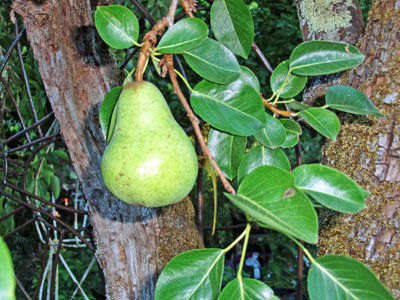
Every year about this time, I get excited about what fruit trees I’m going to recommend for those who want to start a home orchard or add to their edible gardens. Will this be the year you get a Cox’s Orange Pippin apple or an American Golden Russet? Maybe an oldie but goodie like a Golden Delicious apple will become the treasure of your family. But, then again, there’s the Mutsu, a favorite of connoisseurs, which might get the nod.
Here’s why these classic apple varieties are my favorites:
Cox’s Orange Pippin is an old favorite dessert apple. It is firm but juicy, with a sweet, rich flavor that’s not tart. This apple has a distinctive aroma that you won’t forget. The skin is unusual, being orange red to bright red over yellow. Ripening in mid- to late August, it’s a good apple for baking or eating fresh. Cox’s Orange Pippin apples are self-fruitful.
The American Golden Russet apple is one of the great family orchard apples of the 19th century. It is crisp, aromatic and slightly acidic, with creamy yellow flesh that has great flavor and delicious sugary juice. It ripens in early October but will hang on the tree until frost. Russets don’t need to be refrigerated after harvest. If kept cool, they will keep until March or April. You can also dehydrate them. This tree is vigorous and has good disease resistance. Originating in New York sometime in the 1700s, it has remained a favorite ever since.
Everybody is familiar with the Golden Delicious apple. Its popularity is well earned, as it’s both a good cooking apple and great for eating. I like them both slightly green and fully ripened. It’s a reliable producer and good source of pollen for other apple varieties that are not self-fruitful.
Another favorite apple of mine is the Mutsu. These apples are large, crisp and flavorful. They ripen from late September into October. You can pick this apple when it’s green or wait until it is partly yellow. Matsu trees require a pollenizer, such as Granny Smith, Fuji, Gala or Red Delicious.
No matter what kind of fruit you favor, be it apricot, apple, pear, cherry, fig or anything else, now is the time to shop for bare-root fruit trees while they are still dormant. Once leaves emerge or flower buds start to swell, your tree or shrub’s roots have already started growing, and they won’t settle in as well.
Bare-root plants are carefully dug up at growing grounds with their roots bare, meaning that most of the dirt around the roots has been removed. One of the largest growers harvests 2 million bare-root plants in a 30-day period, usually in December.
One of the primary advantages of bare-root plants is that they tend to have an extensive, well-developed root system as a result of being allowed to develop normally. When the trees are handled well, the root system is left intact, and the tree, shrub, vine or berry will have a better chance of rooting well and surviving when planted. Bare-roots don’t have to adapt to any differences between container soil and your gardens.
Almost all fruit tree varieties will grow well in the mountains. We have well over 500 chilling hours per winter. Most of us get 700 to 900 hours.
What does that mean? Many fruit trees, lilacs, and peonies need a certain number of hours during dormancy when the temperature is 45 degrees or less. You can give a plant more cold in the winter and it’ll like that just fine. But fewer hours will hurt your results. Those in Santa Cruz near the coast can grow Fuji apples, for instance, but not Red Delicious. In the mountains, we can grow both.
Next week, I’ll cover how to plant your new bare-root tree, shrub or berry.
Jan Nelson, a landscape designer and California certified nursery professional, will answer questions about gardening in the Santa Cruz Mountains. Email her at ja******@*ol.com, or visit www.jannelsonlandscapedesign.com to view past columns and pictures.











